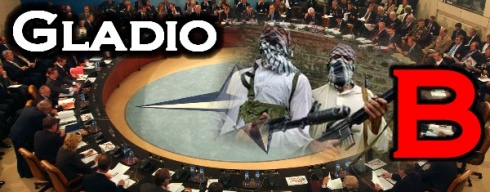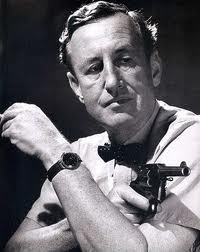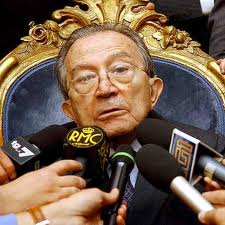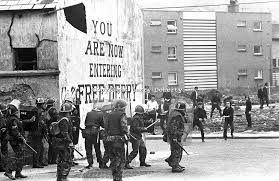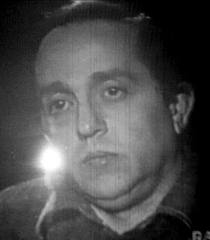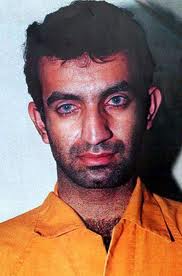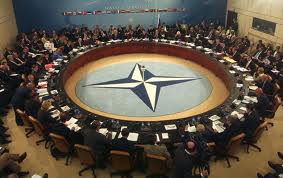Document:Gladio B: The Origins of NATO’s Secret Islamic Terrorist Proxies
Subjects: Operation Gladio/B, Ali Mohamed, Omar Bakri
Source: WideShut.co.uk (Link)
★ Start a Discussion about this document
Gladio B: The Origins of NATO’s Secret Islamic Terrorist Proxies
Contents
Gladio B
At the end of WW2, as the Allied forces withdrew from continental Europe, the American Office of Strategic Services and the British Special Operations Executive left some paramilitary and intelligence units in place in the host countries. These so-called ‘stay behind’ secret armies had been used successfully against the Axis powers during the war, alongside various other commando-type units. Notably, Ian Fleming (author of James Bond) was loosely in charge of the famed 30 Assault Unit, and his brother was involved in setting up the stay-behinds used during the war.
The purpose of these secret armies in the post-war period was to act as a first resort fall back option in case of a Soviet invasion of Western Europe. However they also had an implicit mission of harassing the Soviets pro-actively in time-honoured guerrilla fashion. During the Yalta conference Josef Stalin referred to this, talking about “agents of the London government connected with the so-called resistance” in Poland who had killed 212 Russian soldiers. Franklin Roosevelt suggested that would be a good point to adjourn the meeting, before Winston Churchill, without explicitly denying what Stalin had claimed, said, “I must put on record that both the British and Soviet governments have different sources of information in Poland and get different facts.” Given that it was Churchill who notoriously gave the order that British commando and resistance forces “set Europe ablaze”, the old soak was clearly just covering his back with this remark.[1]
So, when the war ended this mission continued, with secret military and intelligence units operating in all the NATO member states, and even in those countries that were not members of NATO such as Sweden and, at least for a time, France. Only select members of the governments of the host countries were let in on the secret – sometimes even the heads of governments were kept in the dark by those within the military and intelligence institutions who were in the know. As such, the stay behind armies operated in the shadows, with almost no public recognition of their influence until 1990, when then Italian Prime Minister Giulio Andreotti admitted that the units in Italy, codenamed Gladio, did exist and had existed for decades.
The Third Mission
What Andreotti did not admit, but what has become clear through various official and unofficial investigations since then, is that the secret armies developed a third mission, namely, countering the domestic support for Communist and Socialist ideologies, policies and parties. MI5 files now available via the National Archives show that the paranoia in Western intelligence agencies about Communist political subversion took hold even before WW2, let alone the Cold War. Just as they had spied on, infiltrated and manipulated the turn of the century Anarchist movement, they subjected the trade unions, the labour movement, all Communist groups and many suspected Communists in positions of public authority (such as authors) to the same tactics. They even spied on their own former spies, including Arthur Ransome, who had been in Russia during the Bolshevik revolution keeping an eye on Leon Trotsky.
Exactly when the pro-active part of the secret armies mission was turned into a means for domestic counter-subversion is not clear. At some point in the 1950s or 1960s there was a change in strategy that used the secret armies not just to gather intelligence on these groups and individuals, but to destroy their support through violence. Numerous terrorist outrages, from Turkey to Ireland, were instigated, provoked or simply carried out by members of the secret armies, including numerous bombings in Italy and the assassination of Aldo Moro, the Oktoberfest bombing in Munich and the Brabant Massacres in Belgium. All forms of urban terrorism were perpetrated, often by neo-Fascists posing as Leftists, in order to terrify the public, polarise public opinion and destroy support for mainstream Leftist political movements. The process was a great success, ultimately contributing to the downfall of the Soviet Union and ensuring that the policies chosen by the leaders of NATO countries were in keeping with the overall trajectory desired by the Anglo-American establishment.[2]
This story is relatively well-known among students of alternative history and advocates of alternative media, though the operation of the secret army here in the UK has not been subject to the detailed research of, for example, the Italian Gladio.
Perhaps this is a matter of semantics, because at the moment the stay behind units on the continent started their reign of terror, the Irish ‘Troubles’ also began. The same tactics were applied to the political movement for independence in Ireland as to the democratic Communist movement in Italy and elsewhere. Both the Republican and Loyalist radical factions were infiltrated, radicalised, militarised and set down a path of self-destructive and counter-productive violence. This issue of collusion in the Irish conflict has, like the stay behind armies, been outlined in numerous official and unofficial inquiries, most prominently the Cory inquiry.[3]
While this knowledge about Gladio and the other secret armies is extremely significant, it is largely historical. There is no threat of domestic subversion from Communism anymore, either real or fabricated, and the world has kept on spinning. While the Irish conflict still simmers, the prolonged campaign of urban terrorism on the British mainland ended over 15 years ago, and so one might well ask why is this still important?
Gladio Part B
The answer to that question has been provided through a series of exceptional interviews with former FBI translator and respected whistleblower Sibel Edmonds, carried out by “one of the world’s few remaining 9/11 conspiracy theorists” James Corbett. Over the last few weeks, Edmonds has outlined how the contemporary spy-game around radical Islam, documented in the works of Nafeez Ahmed among others, is actually a follow-on from Gladio. She refers to it as ‘Gladio B’, identifying a change in policy around 1996, following the [Suserluk incident]] that once again betrayed the forces at work in the Turkish deep state.
To paraphrase Edmonds: though the collusion with radical Islam had been going on for decades, it wasn’t until 1996 that a formal decision was made by NATO to abandon their previous secret relationship with neo-Fascists and arch-Nationalists and replace them with Islamists.
This is corroborated by a lot of data, for example the international Islamist organisation Al-Muhajiroun suddenly became very prominent in the UK in 1996-7. Omar Bakri, who later admitted to being an MI5 informant, was a key figure in Al-Muhajiroun and its partner organisations like the International Islamic Front. They were central to the process by which young Muslims were recruited, radicalised, trained and sent to fight NATO’s war of destabilisation in the Balkans.
Likewise Al Muqatila, more commonly known as the Libyan Islamic Fighting Group or LIFG, were also prominent in Britain at this time. Following their failed assassination attempt against Colonel Gaddafi in February 1996 several senior members of the group moved to Britain and established their main office there. Among them was Anas Al-Liby, who was probably an MI6 agent recruited as part of their sponsorship of the assassination attempt. He lived in Manchester from 1996 until 2000, having been granted political asylum. A raid on houses connected to Al-Liby in May 2000 resulted in several arrests, but Al-Liby slipped away, probably tipped off by the authorities.[4]
According to Edmonds, since that time the Gladio B operation has expanded and includes the radical Islamisation of Central Asia and the Caucasus region specifically and across the Middle East more generally. Again, much of the available information supports her claims, especially regarding the Gulen Movement, but also NATO’s relationship with Islamist organisations such as the Muslim Brotherhood and with terrorist groups like Jundullah who are destabilising Iran and the MEK/MKO. Most of this can be gleaned from reading mainstream media reports with the right kind of eyes and ears, and by being patient enough to tolerate their habit of dropping occasionally truthful stories into their mix, but never teasing out the implications or sticking with the story to see where it leads. We are however still left with a key question.
When Did Gladio A Become Gladio B?
While much of Edmonds’ analysis of Gladio B is eminently verifiable by those who know where to look, and chimes with much of my own work on terrorist double and triple agents, there is a lot of information that suggests that at least the idea of replacing the Fascist Gladio A with the Islamist Gladio B had occurred to strategists much earlier. The exposing of Gladio A began in Turkey in the 1970s, gaining considerable attention when several Gladio documents were published. These included U.S. Army Field Manual 31-15: Operations Against Irregular Forces, a 1960s US special warfare training manual that had been translated into Turkish.[5] It was perhaps inevitable that following the Turkish revelations that the overall Gladio story would have to be admitted, rendering it a bit useless.
Meanwhile in Italy a judge named Felice Casson was investigating various acts of terrorism including the 1972 Peteano bombing. This eventually led him to the perpetrator – Vincenzo Vinciguerra, a neo-Fascist and member of Ordine Nuovo and Avanguardia Nazionale who had been spirited out of the country after the bombing and protected by the international Gladio network. Vinciguerra was brought back to Italy and he started to talk, explaining the whole operation. At this point his protection was stopped, and he was subsequently put on trial. If the information coming out of Turkey wasn’t enough to signal to NATO that the veil of secrecy around the secret armies was wearing thin, then Vinciguerra’s testimony certainly was.
Fortunately for them, it was at this point in the story of NATO’s collusion with radical Islam that Ali Mohamed entered the fray in a significant way. In 1984, as Vinciguerra was laying out the story of Gladio in Italy, Ali offered his services to the CIA, who signed him up. He was sent to spy on Hezbollah in Germany, which he did by using the ‘dangled mole’ tactic and revealing to his targets that he was working for the CIA but trying to convince them he was still loyal to their side. Even though he infiltrated the group successfully he was supposedly fired by the CIA at this point for being untrustworthy.[6]
However, there is a lot of evidence that this was all a piece of theatre, designed to make Ali a deniable agent for use as a deep-cover spy. For one thing, Ali’s first contact with the CIA wasn’t when he approached them in Cairo in 1984, but when they approached him in America in 1981. While members of the same Egyptian army squadron as Ali were assassinating Anwar Sadat, Ali was on a four month training scheme at Fort Bragg in North Carolina. While there he was approached by the CIA who were looking to recruit him. Despite its implications this information remarkably comes from official sources; namely the Combating Terrorism Center at West Point. They produced a biographical sketch of Ali Mohamed describing the 1981 contact and citing as their source an interview with Dan Coleman, the FBI agent seconded to the CIA’s Bin Laden unit who debriefed Ali after he was ultimately arrested. That profile is no longer available on the West Point Center’s website (I can’t think why) but is available via the Wayback Machine.[7]
Furthermore, if Ali was considered unreliable in 1984 then why did they arrange a visa for him to fly to the US in 1985? Why did they not alert anyone to the danger he posed when he applied to join the army? Why did they send an agent to meet him again at Fort Bragg after his application was successful and he was posted to the US Army’s Special Warfare Center? Why did everyone who knew him, from his wife and friends in California, to his commanders at Fort Bragg, think that he was still working for the CIA throughout this period?
Ali Mohamed: Gladio B Operative?
The significance of this is that Ali was to Al Qaeda what Yves Guerin-Serac and Pino Rauti were to the Aginter Press and Ordine Nuovo – an experienced special forces spy who could turn wild-eyed recruits into hardened men capable of acts of extreme violence. Ali was Al Qaeda’s principle trainer from the late 1980s until his arrest in 1998. One key location was the Al-Kifah refugee centre in New York, taken over in the early 1990s by followers of the Blind Sheikh Omar Abdel Rahman who, like Ali, got into the US on a CIA-sponsored visa. The Al-Kifah hosted training sessions and seminars led by Ali, and this went on both during the Soviet-Afghan War – and while Ali was posted to Fort Bragg – and after the war had ended – and Ali was still in the US army reserve and applying for jobs with the FBI.
Ali’s trainees in New York perpetrated the 1993 World Trade Center bombing, and he probably also trained Ramzi Yousef, the self-proclaimed mastermind of the bombing. They were certainly in the same area of Afghanistan, circulating in the same training camps throughout much of 1992. When Ramzi and his companion arrived in New York in September 1992 they were carrying with them books of bomb recipes translated into Arabic, likely the product of Ali Mohamed’s work[8]. Although he was listed as an unindicted co-conspirator in one of the WTC trials, Ali never testified in those trials even though he was called as a witness for the defence who were arguing that his activities at the Al-Kifah were officially sanctioned by the US government as a follow on from Operation Cyclone, the backing of the Afghan Mujahideenduring the Soviet occupation.
In the years after the WTC bombing, Ali virtually ran the 1998 African embassy bombings operation under the pseudonym ‘Jeff’. According to his extensive confession he carried out surveillance on the American Embassy in Nairobi in late 1993 that was used to decide how to bomb the building several years later.[9] Alongside him doing the surveillance was Anas Al-Liby, the LIFG member who moved to Manchester, England a couple of years later. When Al-Liby’s home was raided in May 2000 the authorities found a copy of the Al Qaeda training manual that written by Ali Mohamed. Just as with the training documents for the Turkish kontrgerilla secret army, the Al Qaeda training manual was adapted and translated from US army manuals that Ali had stolen from Fort Bragg.
With these sorts of connections and parallels we should ask whether the preliminary steps of what has become Gladio B were being taken, via Ali Mohamed, for more than a decade prior to the formal decision identified by Sibel Edmonds as taking place in 1996. One key aspect of Gladio, beyond using proxies to carry out violence and spread ideology to try to reshape the world, is the creation of an enemy image. Just as the Red Brigades in Italy, the Red Army Faction in Germany, the Irish Republican Army in the UK and Ireland, among others, were infiltrated by Gladio agents and manipulated into functioning as symbols for fear and hatred, the same thing has happened with Al Qaeda. Ali Mohamed was instrumental in this process, helping Al Qaeda to carry out the terrorist attacks in the 1990s that would then make it plausible, at least to a large section of the public, that they were also responsible for 9/11.
Regardless of the exact origins of Gladio B and precisely when the shift in policy occurred what is clear is that Sibel Edmonds’ story of a large scale effort on the part of NATO to engage radical Islam as a proxy force, through a network of collusion, assets, double agents and straight-up foot-soldiers following orders, is true. The aims and strategies of the new model of NATO terrorism is still to a large extent the same as the old one – use urban terror to scare the domestic population away from constructive policies and towards the consolidation of the security state, provide an enemy image, provide a guerrilla force to harass Russia and China, and to assist in the overthrow of target governments. Gladio is alive and well, it has just shifted gears.[10]
References
- ↑ Operation Gladio Document Collection, http://www.investigatingtheterror.com/documents/Operation_Gladio_Document_Collection.htm
- ↑ A fuller account of all the different incidents identified as part of Gladio is offered by Daniele Ganser’s NATO’s Secret Armies and Richard Cottrell’s Gladio: NATO’s Dagger at the Heart of Europe
- ↑ Cory Collusion Inquiry Reports, http://cain.ulst.ac.uk/issues/collusion/index.html
- ↑ MI6 ‘halted bid to arrest bin Laden’, http://www.guardian.co.uk/politics/2002/nov/10/uk.davidshayler
- ↑ US FM 31-15 can be downloaded here: http://archive.org/details/FM31-151961
- ↑ History Commons timeline on Ali Mohamed, http://www.historycommons.org/entity.jsp?entity=ali_mohamed
- ↑ West Point Combating Terrorism Center’s Ali Mohammed: A Biographical Sketch, http://web.archive.org/web/20090109031638/http://ctc.usma.edu/harmony/profile_pdf/Ali-Mohammed.pdf
- ↑ WTC93 Document Collection,
- ↑ Ali Mohamed Guilty Plea, http://cryptome.org/usa-v-mohamed.htm
- ↑ The James Corbett interviews with Sibel Edmonds are best watched or listened to in the order they were recorded, http://www.corbettreport.com/interview-595-sibel-edmonds-on-nato-terrorism-911-and-drug-running/
